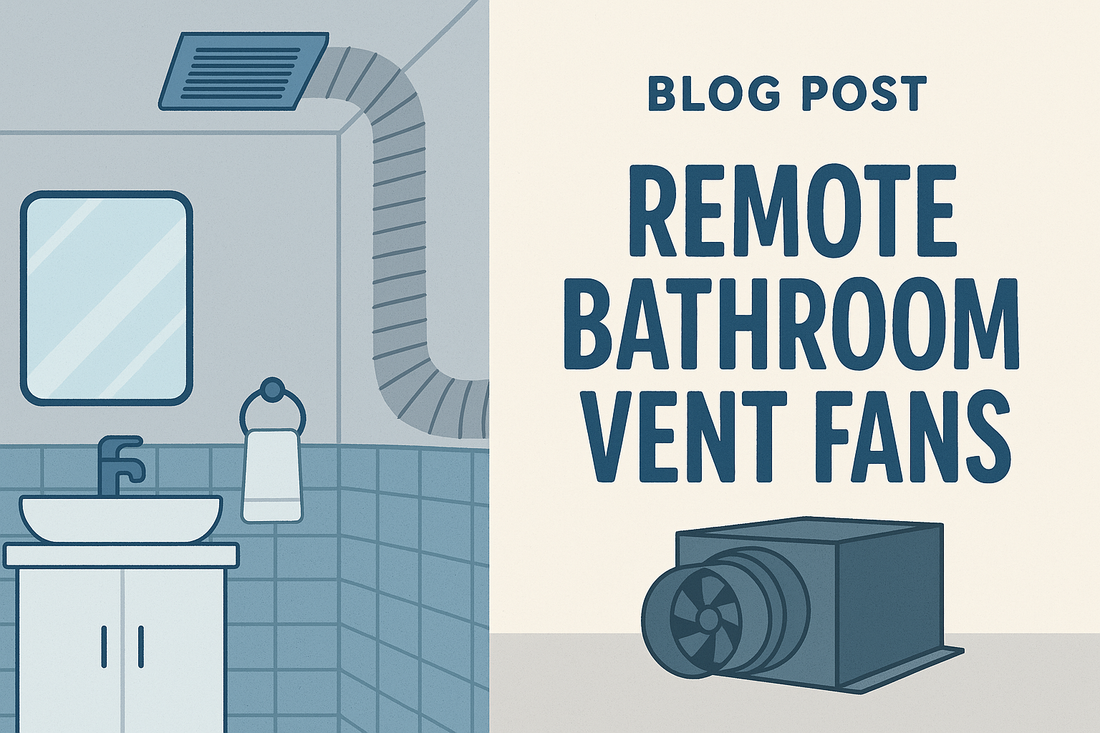
Everything You Need to Know About Bathroom Vent Fans: Remote/Inline vs. Ceiling-Mounted
Share
Proper ventilation in your bathroom isn't just a luxury—it's essential for maintaining a healthy, comfortable home. Bathroom vent fans play a crucial role in removing excess moisture, eliminating odors, and preventing mold growth. When choosing the right ventilation solution for your space, you'll encounter two primary options: remote/inline fans and ceiling-mounted fans. Let's explore both types to help you make an informed decision.
Understanding Bathroom Ventilation Basics
Before diving into specific fan types, it's important to understand why bathroom ventilation matters. A properly ventilated bathroom:
- Prevents mold and mildew growth
- Reduces humidity that can damage fixtures and finishes
- Eliminates unpleasant odors
- Improves overall air quality
- Protects your home's structural elements from moisture damage
Remote/Inline Bathroom Vent Fans: The Quiet Solution
Remote or inline bathroom vent fans (these terms refer to the same type of system) are positioned away from the bathroom itself—typically in an attic, basement, or within the ductwork between the bathroom and the exterior exhaust point.
Advantages of Remote/Inline Fans
Reduced Noise: Perhaps the most significant benefit of remote/inline fans is their whisper-quiet operation. Since the motor is located away from the bathroom, you'll experience minimal noise when the fan is running.
Powerful Performance: Remote/inline fans can often provide stronger ventilation capacity than standard ceiling fans, making them ideal for larger bathrooms or spaces with high moisture levels.
Single Fan, Multiple Vents: One remote/inline fan can often be connected to multiple vents throughout your home, providing efficient ventilation for several bathrooms or humid areas.
Installation Flexibility: These fans can be positioned at various points along the ductwork, offering more installation options than ceiling-mounted units.
Energy Efficiency: Many remote/inline fans are designed with energy efficiency in mind, potentially reducing your electricity costs over time.
Considerations for Remote/Inline Fans
Remote/inline fans generally require more extensive installation work and may be more expensive upfront. They also need sufficient space for mounting away from the bathroom and potentially longer ductwork runs.
Ceiling-Mounted Bathroom Vent Fans: The Traditional Option
Ceiling-mounted fans are the conventional choice, installed directly in the bathroom ceiling with the motor and fan assembly housed in the same unit above the ceiling.
Advantages of Ceiling-Mounted Fans
Simpler Installation: These fans are typically easier and less expensive to install, especially in new construction or straightforward replacements.
Space Efficiency: No need for additional space in attics or within ductwork—everything is contained in one unit in the ceiling.
Cost-Effective: Generally less expensive than remote/inline systems, both for the unit itself and the installation.
Readily Available: Wide variety of models, styles, and features available at most home improvement stores.
Easy Maintenance: More accessible for cleaning and maintenance than remote/inline systems.
Considerations for Ceiling-Mounted Fans
The primary drawback of ceiling-mounted fans is noise—the motor and fan are located directly in your bathroom, which can create a noticeable sound when operating. They may also provide less powerful ventilation than their remote/inline counterparts, particularly for larger spaces.
Making Your Decision
When choosing between remote/inline and ceiling-mounted bathroom vent fans, consider:
Noise Sensitivity: If quiet operation is a priority, remote/inline fans are your best option.
Available Space: Limited attic or installation space may make ceiling-mounted fans more practical.
Budget: Ceiling-mounted systems typically cost less to purchase and install than remote/inline options.
Multiple Bathroom Needs: Remote/inline fans excel when ventilating multiple bathrooms simultaneously.
Installation Complexity: Ceiling-mounted fans generally require less complex installation.
Installation Tips
Whichever type you choose, proper installation is crucial:
- Ensure ductwork is properly sealed to prevent leaks
- Route exhaust to the exterior of your home (never into an attic or crawlspace)
- Select the appropriate fan size based on your bathroom's square footage
- Consider adding a timer or humidity sensor for automated operation
- Follow local building codes regarding bathroom ventilation
Maintenance Matters
Both fan types require regular maintenance:
- Clean grilles and vents every few months to remove dust buildup
- Check and clean fan blades annually
- Listen for unusual noises that might indicate worn bearings or other issues
- Ensure ductwork remains connected and sealed properly
Final Thoughts
Whether you opt for a whisper-quiet remote/inline fan or a more economical ceiling-mounted model, investing in proper bathroom ventilation will pay dividends in protecting your home and enhancing comfort. Consider your specific needs, budget, and home configuration when making your choice.
Remember that professional installation is often worth the investment, especially for remote/inline systems that require more complex setup. A properly installed and maintained bathroom vent fan will serve your home well for many years to come.
